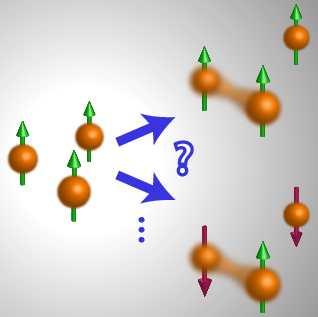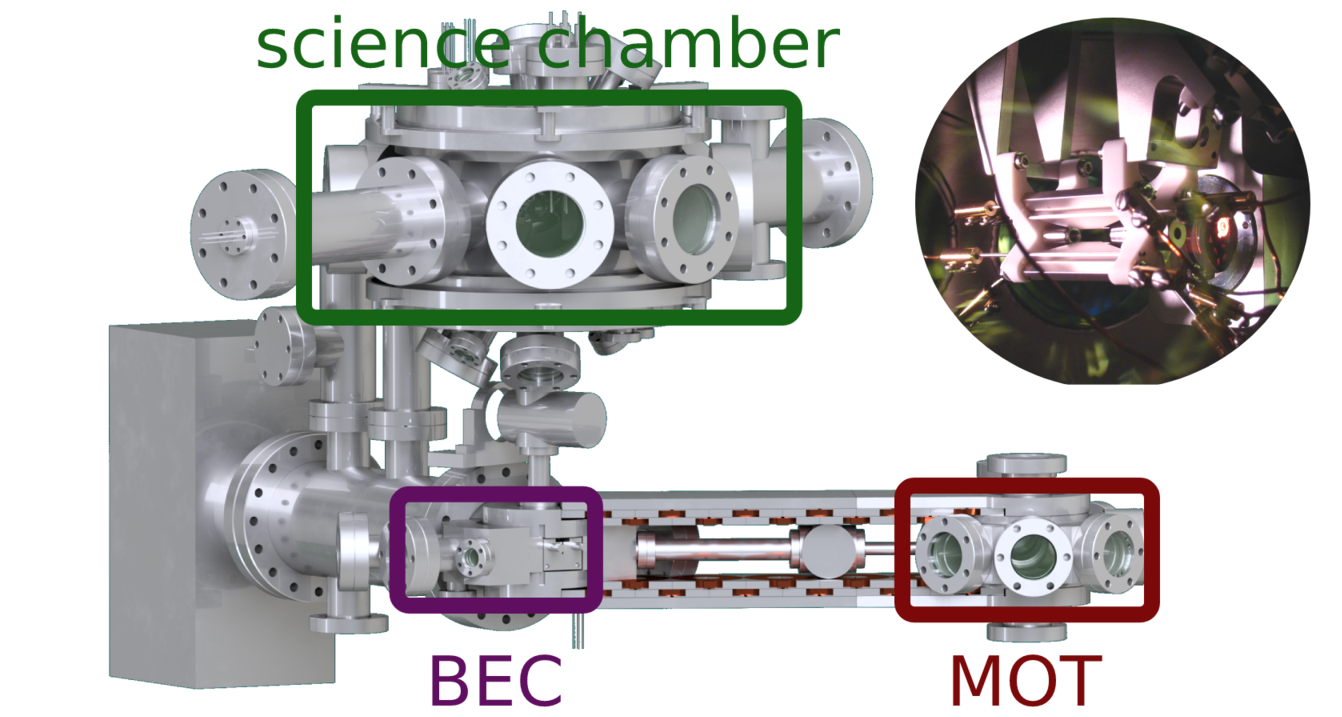BaRbIE Lab
- An ion in a sea of ultracold atoms -
Our research interest
- Ultracold atom-ion collisions
- Controlled state-to-state chemistry
- Rydberg physics in a hybrid trap
Our atom-ion hybrid setup enables us to study very interesting phenomena such as atom-ion reactive collisions and chemical reactions in atomic ensembles in a state-to-state fashion.

Ongoing research projects
- Detection of charged Rydberg molecules
In an atom-ion mixture, a novel type of molecule based on ion-Rydberg atom interaction is accessible (see Atoms 9(2), 34 (2021)). We are currently working on creation and detection of such molecular ions via photoassociation using an ultraviolet laser source.
- Controlled state-to-state chemistry in ultracold atoms
We explore ultracold chemical reactions in many-body collisions in neutral atomic ensembles in a quantum-state-resolved fashion. In particular, we are currently investigating the propensity rules and scaling laws for unraveling the quantum nature of chemical processes at ultracold temperatures. Furthermore, we aim at controlling chemical reactions via external electromagnetic fields.



Published research highlights

Spin-conservation propensity rule for three-body recombination of ultracold Rb atoms
S. Haze et. al Phys. Rev. Lett. 128, 133401 (2022)
We explore the physical origin and the general validity of a propensity rule for the conservation of the hyperfine spin state in three-body recombination. This rule was recently discovered for the special case of Rb87 with its nearly equal singlet and triplet scattering lengths. Here, we test the propensity rule for Rb85 for which the scattering properties are very different from Rb87. The Rb2 molecular product distribution is mapped out in a state-to-state fashion using resonance-enhanced multiphoton ionization detection schemes which fully cover all possible molecular spin states. Interestingly, for the experimentally investigated range of binding energies from zero to ∼13 GHz×h we observe that the spin-conservation propensity rule also holds for Rb85. From these observations and a theoretical analysis we derive an understanding for the conservation of the hyperfine spin state. We identify several criteria to judge whether the propensity rule will also hold for other elements and collision channels.

Life and death of a cold BaRb+ molecule inside an ultracold cloud of Rb atoms
A. Mohammadi et. al. Phys. Rev. Research 3, 013196 (2021)
We study the evolution of a cold single BaRb+ molecule while it continuously collides with ultracold Rb atoms. The initially weakly bound molecule can undergo a sequence of elastic, inelastic, reactive, and radiative processes. We investigate these processes by developing methods for discriminating between different ion species, electronic states, and kinetic ion energy ranges. By analyzing the experimental data while taking into account theoretical insights, we obtain a consistent description of the typical trajectory through the manifold of available atomic and molecular states. Monte Carlo simulations describe the measured dynamics well. As a further result, we determine rates for collisional and radiative relaxation as well as photodissociation, spin-flip collisions, and chemical reactions.

Obvervation of spin-orbit-dependent electron scattering using long-range Rydberg molecules
M. Deiß et. al. Phys.Rev. Research 2, 013047 (2020)
We present experimental evidence for spin-orbit interaction of an electron as it scatters from a neutral atom. The scattering process takes place within a Rb2 ultralong-range Rydberg molecule, consisting of a Rydberg atomic core, a Rydberg electron, and a ground state atom. The spin-orbit interaction leads to characteristic level splittings of vibrational molecular lines which we directly observe via photoassociation spectroscopy. We benefit from the fact that molecular states dominated by resonant p-wave interaction are particularly sensitive to the spin-orbit interaction. Our work paves the way for studying novel spin dynamics in ultralong-range Rydberg molecules. Furthermore, it shows that the molecular setup can serve as a microlaboratory to perform precise scattering experiments in the low-energy regime of a few meV.
Are you interested in joining our team? Do you want to explore the exciting field of ultracold quantum gases? Please get in touch with us!
Further Information about the BaRbIE laboratory
Experimental apparatus
The heart of our experimental apparatus is the science chamber. It's unique feature is the hybrid setup of a linear Paul trap and a crossed optical dipole trap. This enables us to trap charged particles as Rb+ and Ba+ and let them collide with an ultracold cloud of Rb85/87 atoms. For a more detailed view and further explanations also about our MOT and BEC chamber, please visit BaRbIE experiment.


The team (left to right)
- Dr. Markus Deiß
- Dominik Dorer
- Dr. Shinsuke Haze
- Prof. Dr. Johannes Hecker Denschlag
